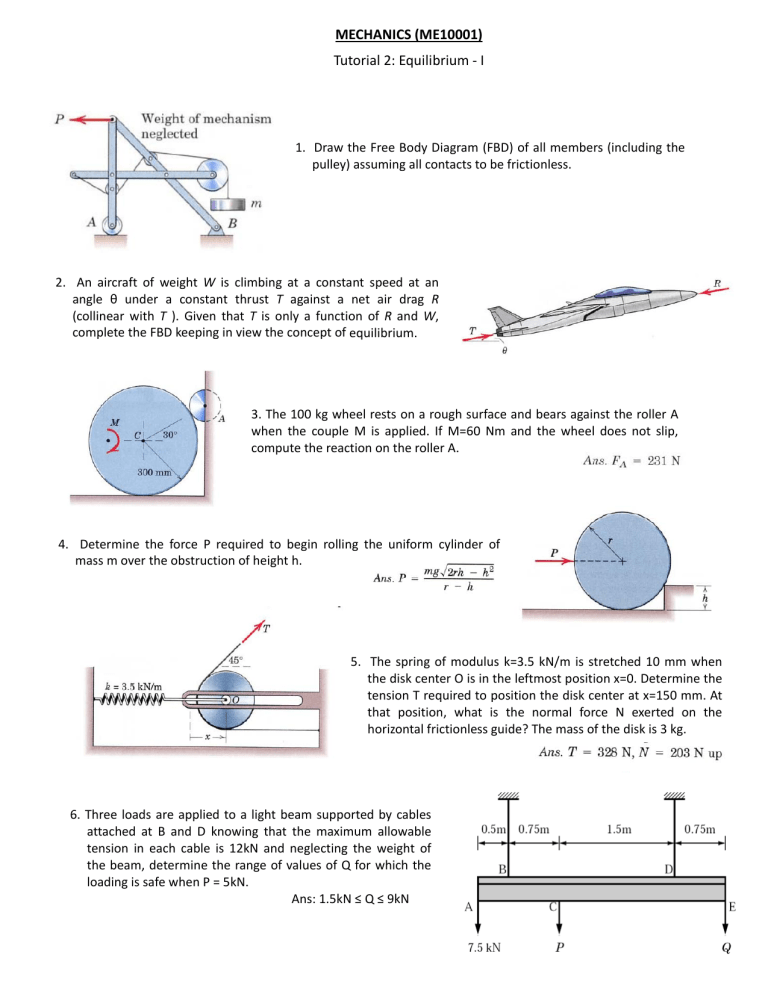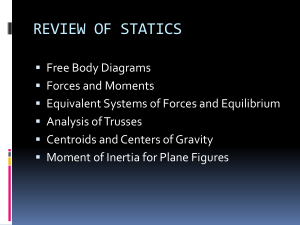Mechanics Equilibrium Tutorial: Free Body Diagrams & Forces
advertisement

MECHANICS (ME10001) Tutorial 2: Equilibrium ‐ I 1. Draw the Free Body Diagram (FBD) of all members (including the pulley) assuming all contacts to be frictionless. 2. An aircraft of weight W is climbing at a constant speed at an angle θ under a constant thrust T against a net air drag R (collinear with T ). Given that T is only a function of R and W, complete the FBD keeping in view the concept of equilibrium. 3. The 100 kg wheel rests on a rough surface and bears against the roller A when the couple M is applied. If M=60 Nm and the wheel does not slip, compute the reaction on the roller A. 4. Determine the force P required to begin rolling the uniform cylinder of mass m over the obstruction of height h. 5. The spring of modulus k=3.5 kN/m is stretched 10 mm when the disk center O is in the leftmost position x=0. Determine the tension T required to position the disk center at x=150 mm. At that position, what is the normal force N exerted on the horizontal frictionless guide? The mass of the disk is 3 kg. 6. Three loads are applied to a light beam supported by cables attached at B and D knowing that the maximum allowable tension in each cable is 12kN and neglecting the weight of the beam, determine the range of values of Q for which the loading is safe when P = 5kN. Ans: 1.5kN ≤ Q ≤ 9kN 7. Consider the truss. If the roller at B can sustain a maximum load of 3kN, determine the largest magnitude of each of the three forces F that can be supported by the truss. Ans: F=354 N A B 8. Two identical smooth tubes A and B, each of weight W, are suspended at their ends by cords of equal length. A third tube C of weight WC is placed between A and B. Determine the greatest weight of C that can be supported without upsetting equilibrium. Ans: WC =0.776 W 9. A vertical load P is applied at the end B of rod BC. The spring constant of the spring is K and the spring is outstretched when θ = 0. (a) Neglecting the weight of the rod, express the angle θ corresponding to the equilibrium position in terms of P, K and l. (b) Determine the value of θ corresponding to the equilibrium if P = 2Kl. Ans: θ = tan‐1 (P/Kl), θ = 63.44O 10. The lightweight cart of the exercise machine shown is supported by a cable whose other end is pulled by the athlete to raise the cart. In the configuration shown with β=18O, determine the pulling force P applied by the athlete on the cable to maintain equilibrium on the frictionless ramp. Also determine the reaction force R on the cart from the ramp. Take mass of the athlete as 70 kg and θ=15O. 11. The hook wrench is used to turn shafts and collars. If a moment of 80 Nm is required to turn the 200 mm diameter collar about its center O, determine the contact force R on the smooth surface at A. . The engagement of the pin at B may be considered to occur at the periphery of the collar. 12. A special jig consists of an 80 Mg sector mounted on a line of rollers at A and a line of rollers at B. One of the rollers at B is a gear which meshes with a ring of gear teeth on the sector so as to turn the sector about its geometric center O. When α=0, a counterclockwise torque of 2460 Nm must be applied to the gear at B to keep the assembly from rotating. When α=30O, a clockwise torque of 4680 Nm is required to prevent rotation. Locate the mass center G of the jig by calculating ṝ and θ. Note that the mass center of the pipe section is at O.



